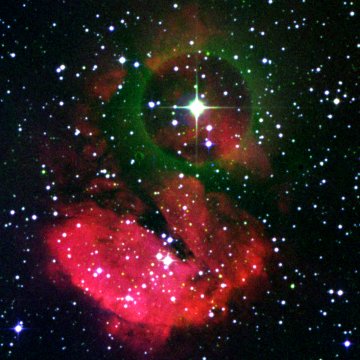Gum 58
Also called
Sh 2-3, RCW 120Coordinates: (348.25°, 0.49°)
[ Catalog | Explorer | SIMBAD ]
RCW 120 was the subject of one of the first published studies based on images from the Herschel infrared space telescope. [3]
According to Avedisova, RCW 120 is ionised by the O8 V star CD -38 11636 (CGO 439) and the B2 V star VDBH 84B. She places the nebula in the star formation region SFR 348.26+0.47 along with 3 masers and the radio HII region [CH87] 347.386+0.266.
A 2005 study refers to the Avedisova paper and gives the class of the main ionising star as O6 V, so the star may be hotter than Avedisova suggests.[4]
You can view an interesting multiwavelength image of RCW 120 and see the Spitzer infrared view here
Notes
1. ^ Zavagno, A., Pomarès, M., Deharveng, L., et al. (2007). "Triggered star formation on the borders of the Galactic H ii region RCW 120", Astronomy and Astrophysics, Vol. 472, 835-846. [2007A&A...472..835Z]
2. ^ Deharveng, L., Zavagno, A., Schuller, F., et al. (2009). "Star formation around RCW 120, the perfect bubble", Astronomy and Astrophysics, Vol. 496, 177-190. [2009A&A...496..177D]
3. ^ Zavagno, A., Russeil, D., Motte, F., et al. (2010). "Star formation triggered by the Galactic H II region RCW 120. First results from the Herschel Space Observatory", Astronomy and Astrophysics, Vol. 518, L81. [2010A&A...518L..81Z]
4. ^ Deharveng, L., Zavagno, A., & Caplan, J. (2005). "Triggered massive-star formation on the borders of Galactic H II regions. I. A search for ``collect and collapse'' candidates", Astronomy and Astrophysics, Vol. 433, 565-577. [2005A&A...433..565D]
Distance estimates
1300 pc [2005A&A...433..565D]1340 pc [2007A&A...472..835Z]
1400 pc +/- 500 [1989BAICz..40...42A]
Links
[ DSS | ADS | ADS Abstract ]
map | book | blog | gallery | sources

This image was created using the POSS-II/UKSTU data of the Digitized Sky Survey and SuperCOSMOS using the process described here.
According to my correspondence with the Royal Observatory Edinburgh and the Space Telescope Science Institute, I am allowed to use the POSS-II/UKSTU data to create and display images for non-commercial purposes so long as I include this fine print for the SuperCOSMOS data:
Use of these images is courtesy of the UK Schmidt Telescope (copyright in which is owned by the Particle Physics and Astronomy Research Council of the UK and the Anglo-Australian Telescope Board) and the Southern Sky Survey as created by the SuperCOSMOS measuring machine and are reproduced here with permission from the Royal Observatory Edinburgh.
and this acknowledgement taken from the DSS site:
The Digitized Sky Surveys were produced at the Space Telescope Science Institute under U.S. Government grant NAG W-2166. The images of these surveys are based on photographic data obtained using the Oschin Schmidt Telescope on Palomar Mountain and the UK Schmidt Telescope. The plates were processed into the present compressed digital form with the permission of these institutions.
The Second Palomar Observatory Sky Survey (POSS-II) was made by the California Institute of Technology with funds from the National Science Foundation, the National Geographic Society, the Sloan Foundation, the Samuel Oschin Foundation, and the Eastman Kodak Corporation.
The UK Schmidt Telescope was operated by the Royal Observatory Edinburgh, with funding from the UK Science and Engineering Research Council (later the UK Particle Physics and Astronomy Research Council), until 1988 June, and thereafter by the Anglo-Australian Observatory. The blue plates of the southern Sky Atlas and its Equatorial Extension (together known as the SERC-J), as well as the Equatorial Red (ER), and the Second Epoch [red] Survey (SES) were all taken with the UK Schmidt.
The "Second Epoch Survey" of the southern sky was made by the Anglo-Australian Observatory (AAO) with the UK Schmidt Telescope. Plates from this survey have been digitized and compressed by the ST ScI. The digitized images are copyright ? 1993-5 by the Anglo-Australian Observatory Board, and are distributed herein by agreement.
The "Equatorial Red Atlas" of the southern sky was made with the UK Schmidt Telescope. Plates from this survey have been digitized and compressed by the ST ScI. The digitized images are copyright ? 1992-5, jointly by the UK SERC/PPARC (Particle Physics and Astronomy Research Council, formerly Science and Engineering Research Council) and the Anglo-Australian Telescope Board, and are distributed herein by agreement.
The compressed files of the "Palomar Observatory - Space Telescope Science Institute Digital Sky Survey" of the northern sky, based on scans of the Second Palomar Sky Survey are copyright ? 1993-1995 by the California Institute of Technology and are distributed herein by agreement. The compressed files of the "Palomar Observatory - Space Telescope Science Institute Digital Sky Survey" of the northern sky, based on scans of the Second Palomar Sky Survey are copyright ? 1993-1995 by the California Institute of Technology and are distributed herein by agreement.